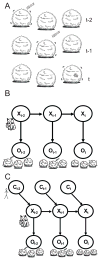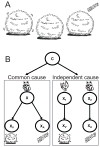Bayesian models: the structure of the world, uncertainty, behavior, and the brain
- PMID: 21486294
- PMCID: PMC3079291
- DOI: 10.1111/j.1749-6632.2011.05965.x
Bayesian models: the structure of the world, uncertainty, behavior, and the brain
Abstract
Experiments on humans and other animals have shown that uncertainty due to unreliable or incomplete information affects behavior. Recent studies have formalized uncertainty and asked which behaviors would minimize its effect. This formalization results in a wide range of Bayesian models that derive from assumptions about the world, and it often seems unclear how these models relate to one another. In this review, we use the concept of graphical models to analyze differences and commonalities across Bayesian approaches to the modeling of behavioral and neural data. We review behavioral and neural data associated with each type of Bayesian model and explain how these models can be related. We finish with an overview of different theories that propose possible ways in which the brain can represent uncertainty.
© 2011 New York Academy of Sciences.
Figures






References
-
- Marr D. Vision: A Computational Approach. Freeman & Co; San Francisco: 1982.
-
- Kording K. Decision theory: what “should” the nervous system do? Science. 2007;318:606–610. - PubMed
-
-
Plato. 360 B.C. Republic.
-
-
- Smith MA. Alhacen’s Theory of Visual Perception. 2001.
-
- Helmholtz HLF. Thoemmes Continuum. 1856. Treatise on Physiological Optics.
Publication types
MeSH terms
Grants and funding
LinkOut - more resources
Full Text Sources

